Workplace Conflict: An In-Depth Analysis of an Interpersonal Situation
VerifiedAdded on 2022/11/03
|6
|1771
|444
Essay
AI Summary
This essay examines an interpersonal conflict between two employees in a software company, where one employee consistently arrives late and avoids work, causing tension and impacting project performance. The conflict stems from differing work ethics and values, leading to a breakdown in communication and a negative working environment. The analysis explores the use of communication channels, power dynamics, and influence tactics, ultimately highlighting the ineffective use of an avoiding strategy for conflict management. The essay suggests third-party involvement, particularly mediation, as a more suitable approach for resolving the conflict and improving future workplace relations. The conclusion emphasizes the importance of addressing conflicts promptly to foster a positive and productive work environment, recommending open communication and adherence to company policies to achieve better performance and shared goals. Desklib offers this and similar assignments for students seeking study resources.
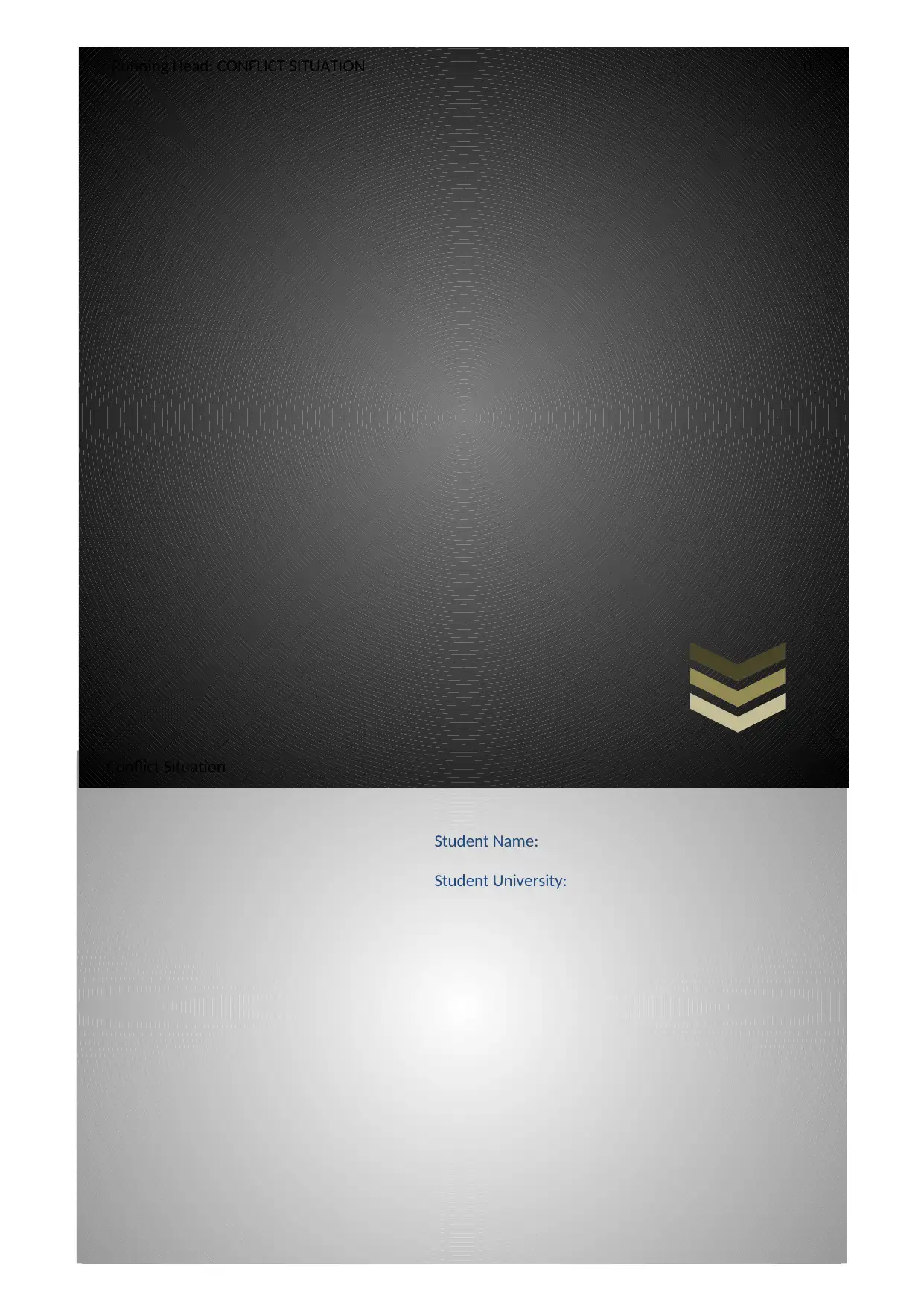
Conflict Situation
Running Head: CONFLICT SITUATION 0
Student Name:
Student University:
Running Head: CONFLICT SITUATION 0
Student Name:
Student University:
Paraphrase This Document
Need a fresh take? Get an instant paraphrase of this document with our AI Paraphraser
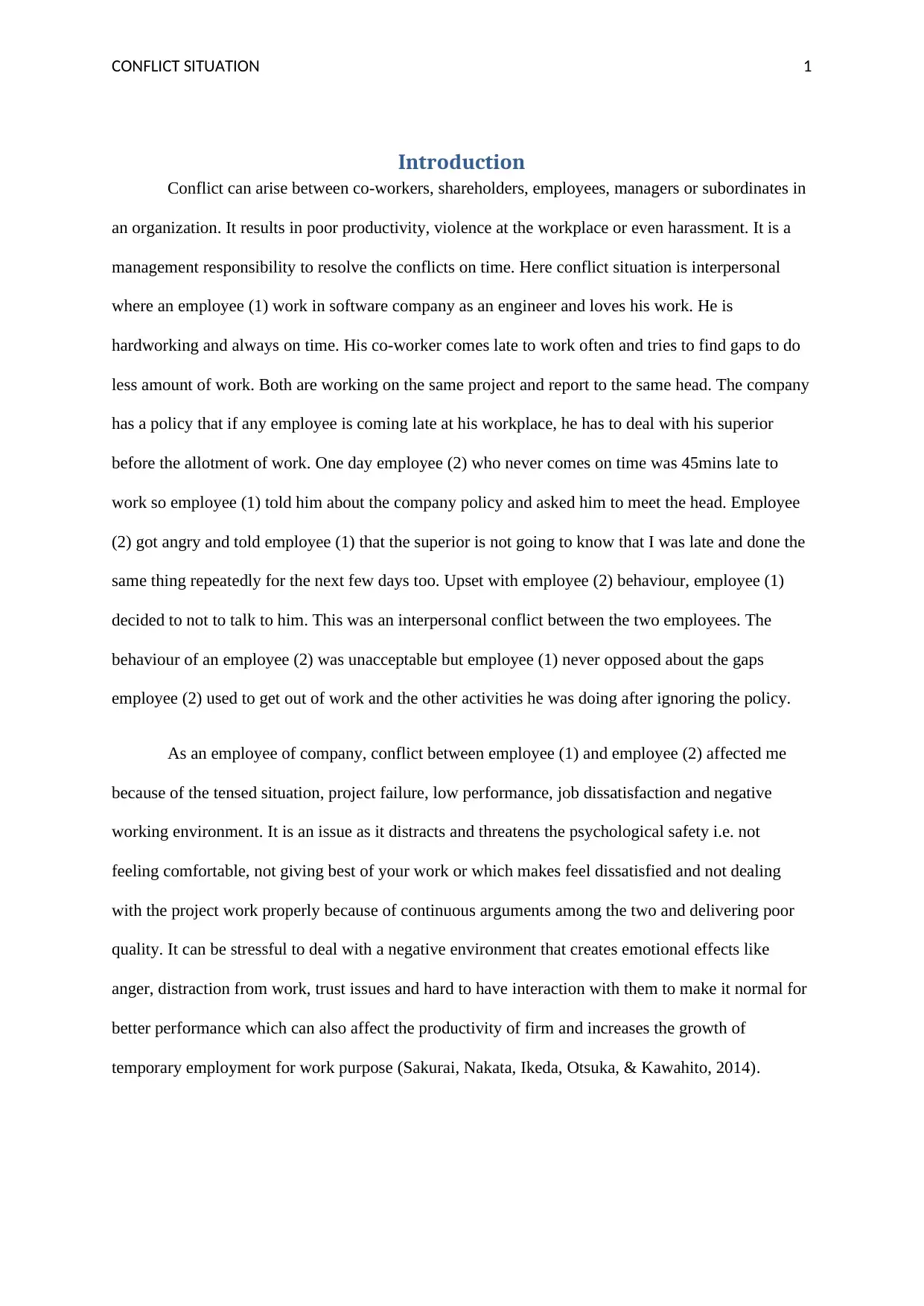
CONFLICT SITUATION 1
Introduction
Conflict can arise between co-workers, shareholders, employees, managers or subordinates in
an organization. It results in poor productivity, violence at the workplace or even harassment. It is a
management responsibility to resolve the conflicts on time. Here conflict situation is interpersonal
where an employee (1) work in software company as an engineer and loves his work. He is
hardworking and always on time. His co-worker comes late to work often and tries to find gaps to do
less amount of work. Both are working on the same project and report to the same head. The company
has a policy that if any employee is coming late at his workplace, he has to deal with his superior
before the allotment of work. One day employee (2) who never comes on time was 45mins late to
work so employee (1) told him about the company policy and asked him to meet the head. Employee
(2) got angry and told employee (1) that the superior is not going to know that I was late and done the
same thing repeatedly for the next few days too. Upset with employee (2) behaviour, employee (1)
decided to not to talk to him. This was an interpersonal conflict between the two employees. The
behaviour of an employee (2) was unacceptable but employee (1) never opposed about the gaps
employee (2) used to get out of work and the other activities he was doing after ignoring the policy.
As an employee of company, conflict between employee (1) and employee (2) affected me
because of the tensed situation, project failure, low performance, job dissatisfaction and negative
working environment. It is an issue as it distracts and threatens the psychological safety i.e. not
feeling comfortable, not giving best of your work or which makes feel dissatisfied and not dealing
with the project work properly because of continuous arguments among the two and delivering poor
quality. It can be stressful to deal with a negative environment that creates emotional effects like
anger, distraction from work, trust issues and hard to have interaction with them to make it normal for
better performance which can also affect the productivity of firm and increases the growth of
temporary employment for work purpose (Sakurai, Nakata, Ikeda, Otsuka, & Kawahito, 2014).
Introduction
Conflict can arise between co-workers, shareholders, employees, managers or subordinates in
an organization. It results in poor productivity, violence at the workplace or even harassment. It is a
management responsibility to resolve the conflicts on time. Here conflict situation is interpersonal
where an employee (1) work in software company as an engineer and loves his work. He is
hardworking and always on time. His co-worker comes late to work often and tries to find gaps to do
less amount of work. Both are working on the same project and report to the same head. The company
has a policy that if any employee is coming late at his workplace, he has to deal with his superior
before the allotment of work. One day employee (2) who never comes on time was 45mins late to
work so employee (1) told him about the company policy and asked him to meet the head. Employee
(2) got angry and told employee (1) that the superior is not going to know that I was late and done the
same thing repeatedly for the next few days too. Upset with employee (2) behaviour, employee (1)
decided to not to talk to him. This was an interpersonal conflict between the two employees. The
behaviour of an employee (2) was unacceptable but employee (1) never opposed about the gaps
employee (2) used to get out of work and the other activities he was doing after ignoring the policy.
As an employee of company, conflict between employee (1) and employee (2) affected me
because of the tensed situation, project failure, low performance, job dissatisfaction and negative
working environment. It is an issue as it distracts and threatens the psychological safety i.e. not
feeling comfortable, not giving best of your work or which makes feel dissatisfied and not dealing
with the project work properly because of continuous arguments among the two and delivering poor
quality. It can be stressful to deal with a negative environment that creates emotional effects like
anger, distraction from work, trust issues and hard to have interaction with them to make it normal for
better performance which can also affect the productivity of firm and increases the growth of
temporary employment for work purpose (Sakurai, Nakata, Ikeda, Otsuka, & Kawahito, 2014).
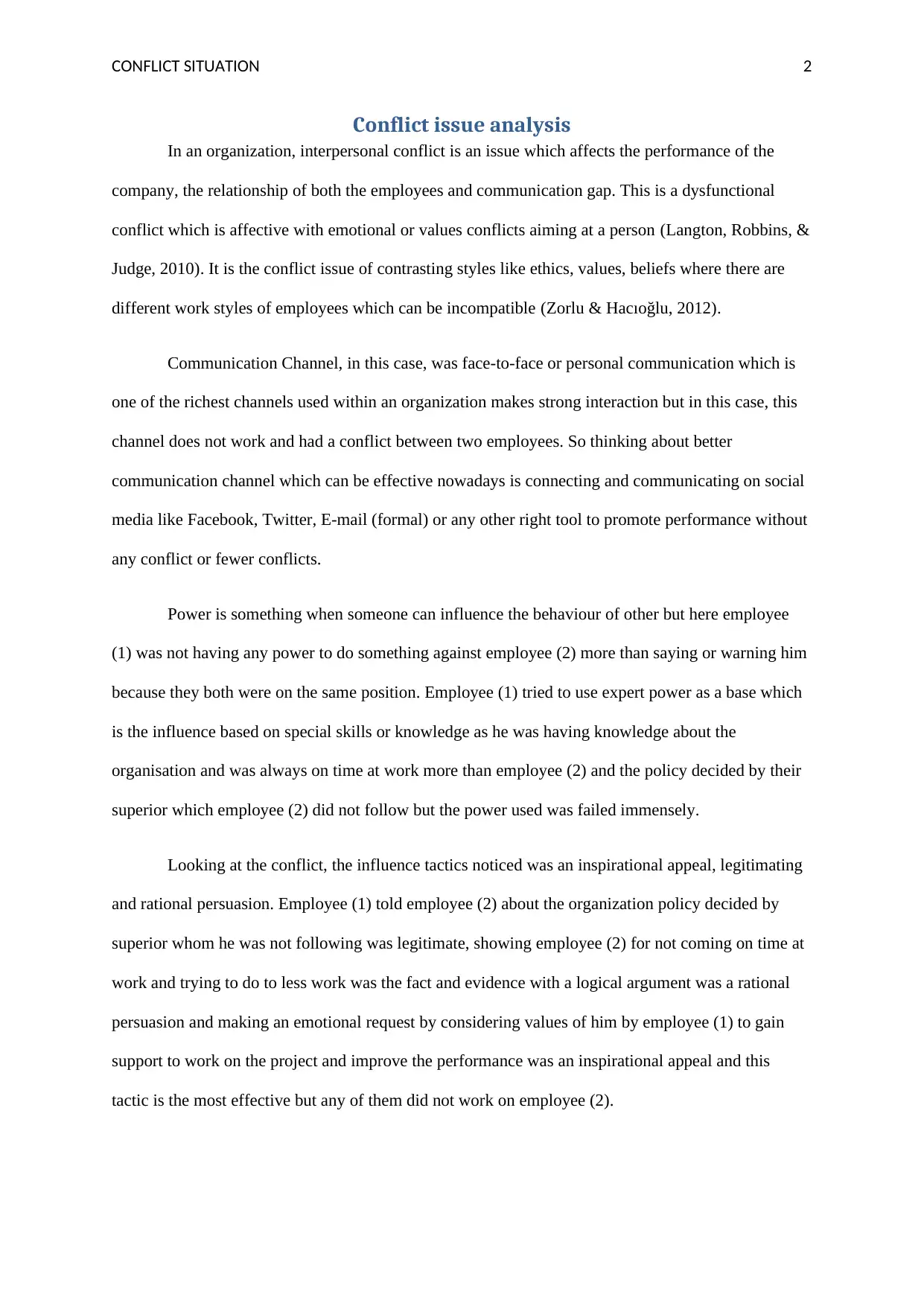
CONFLICT SITUATION 2
Conflict issue analysis
In an organization, interpersonal conflict is an issue which affects the performance of the
company, the relationship of both the employees and communication gap. This is a dysfunctional
conflict which is affective with emotional or values conflicts aiming at a person (Langton, Robbins, &
Judge, 2010). It is the conflict issue of contrasting styles like ethics, values, beliefs where there are
different work styles of employees which can be incompatible (Zorlu & Hacıoğlu, 2012).
Communication Channel, in this case, was face-to-face or personal communication which is
one of the richest channels used within an organization makes strong interaction but in this case, this
channel does not work and had a conflict between two employees. So thinking about better
communication channel which can be effective nowadays is connecting and communicating on social
media like Facebook, Twitter, E-mail (formal) or any other right tool to promote performance without
any conflict or fewer conflicts.
Power is something when someone can influence the behaviour of other but here employee
(1) was not having any power to do something against employee (2) more than saying or warning him
because they both were on the same position. Employee (1) tried to use expert power as a base which
is the influence based on special skills or knowledge as he was having knowledge about the
organisation and was always on time at work more than employee (2) and the policy decided by their
superior which employee (2) did not follow but the power used was failed immensely.
Looking at the conflict, the influence tactics noticed was an inspirational appeal, legitimating
and rational persuasion. Employee (1) told employee (2) about the organization policy decided by
superior whom he was not following was legitimate, showing employee (2) for not coming on time at
work and trying to do to less work was the fact and evidence with a logical argument was a rational
persuasion and making an emotional request by considering values of him by employee (1) to gain
support to work on the project and improve the performance was an inspirational appeal and this
tactic is the most effective but any of them did not work on employee (2).
Conflict issue analysis
In an organization, interpersonal conflict is an issue which affects the performance of the
company, the relationship of both the employees and communication gap. This is a dysfunctional
conflict which is affective with emotional or values conflicts aiming at a person (Langton, Robbins, &
Judge, 2010). It is the conflict issue of contrasting styles like ethics, values, beliefs where there are
different work styles of employees which can be incompatible (Zorlu & Hacıoğlu, 2012).
Communication Channel, in this case, was face-to-face or personal communication which is
one of the richest channels used within an organization makes strong interaction but in this case, this
channel does not work and had a conflict between two employees. So thinking about better
communication channel which can be effective nowadays is connecting and communicating on social
media like Facebook, Twitter, E-mail (formal) or any other right tool to promote performance without
any conflict or fewer conflicts.
Power is something when someone can influence the behaviour of other but here employee
(1) was not having any power to do something against employee (2) more than saying or warning him
because they both were on the same position. Employee (1) tried to use expert power as a base which
is the influence based on special skills or knowledge as he was having knowledge about the
organisation and was always on time at work more than employee (2) and the policy decided by their
superior which employee (2) did not follow but the power used was failed immensely.
Looking at the conflict, the influence tactics noticed was an inspirational appeal, legitimating
and rational persuasion. Employee (1) told employee (2) about the organization policy decided by
superior whom he was not following was legitimate, showing employee (2) for not coming on time at
work and trying to do to less work was the fact and evidence with a logical argument was a rational
persuasion and making an emotional request by considering values of him by employee (1) to gain
support to work on the project and improve the performance was an inspirational appeal and this
tactic is the most effective but any of them did not work on employee (2).
⊘ This is a preview!⊘
Do you want full access?
Subscribe today to unlock all pages.

Trusted by 1+ million students worldwide
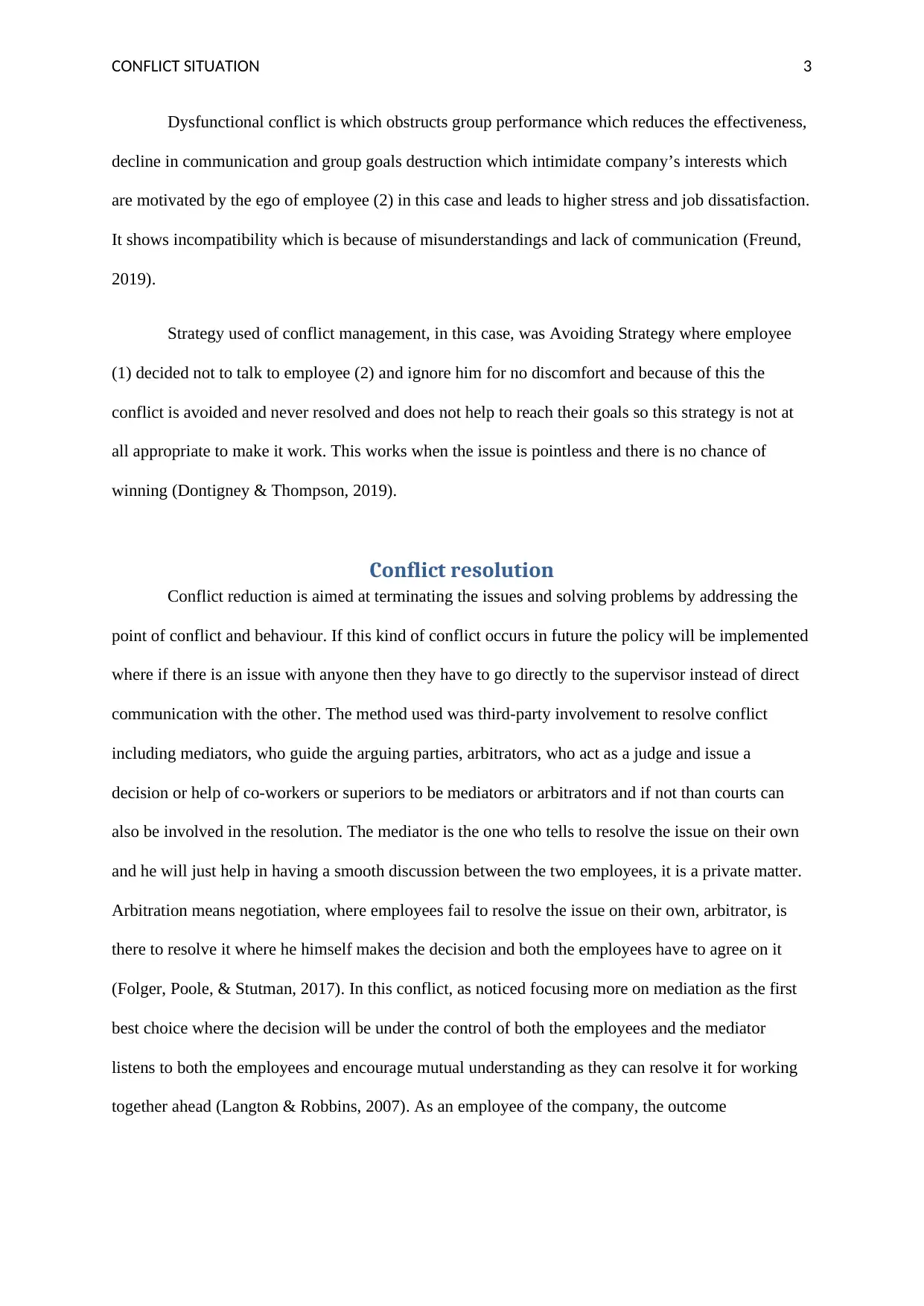
CONFLICT SITUATION 3
Dysfunctional conflict is which obstructs group performance which reduces the effectiveness,
decline in communication and group goals destruction which intimidate company’s interests which
are motivated by the ego of employee (2) in this case and leads to higher stress and job dissatisfaction.
It shows incompatibility which is because of misunderstandings and lack of communication (Freund,
2019).
Strategy used of conflict management, in this case, was Avoiding Strategy where employee
(1) decided not to talk to employee (2) and ignore him for no discomfort and because of this the
conflict is avoided and never resolved and does not help to reach their goals so this strategy is not at
all appropriate to make it work. This works when the issue is pointless and there is no chance of
winning (Dontigney & Thompson, 2019).
Conflict resolution
Conflict reduction is aimed at terminating the issues and solving problems by addressing the
point of conflict and behaviour. If this kind of conflict occurs in future the policy will be implemented
where if there is an issue with anyone then they have to go directly to the supervisor instead of direct
communication with the other. The method used was third-party involvement to resolve conflict
including mediators, who guide the arguing parties, arbitrators, who act as a judge and issue a
decision or help of co-workers or superiors to be mediators or arbitrators and if not than courts can
also be involved in the resolution. The mediator is the one who tells to resolve the issue on their own
and he will just help in having a smooth discussion between the two employees, it is a private matter.
Arbitration means negotiation, where employees fail to resolve the issue on their own, arbitrator, is
there to resolve it where he himself makes the decision and both the employees have to agree on it
(Folger, Poole, & Stutman, 2017). In this conflict, as noticed focusing more on mediation as the first
best choice where the decision will be under the control of both the employees and the mediator
listens to both the employees and encourage mutual understanding as they can resolve it for working
together ahead (Langton & Robbins, 2007). As an employee of the company, the outcome
Dysfunctional conflict is which obstructs group performance which reduces the effectiveness,
decline in communication and group goals destruction which intimidate company’s interests which
are motivated by the ego of employee (2) in this case and leads to higher stress and job dissatisfaction.
It shows incompatibility which is because of misunderstandings and lack of communication (Freund,
2019).
Strategy used of conflict management, in this case, was Avoiding Strategy where employee
(1) decided not to talk to employee (2) and ignore him for no discomfort and because of this the
conflict is avoided and never resolved and does not help to reach their goals so this strategy is not at
all appropriate to make it work. This works when the issue is pointless and there is no chance of
winning (Dontigney & Thompson, 2019).
Conflict resolution
Conflict reduction is aimed at terminating the issues and solving problems by addressing the
point of conflict and behaviour. If this kind of conflict occurs in future the policy will be implemented
where if there is an issue with anyone then they have to go directly to the supervisor instead of direct
communication with the other. The method used was third-party involvement to resolve conflict
including mediators, who guide the arguing parties, arbitrators, who act as a judge and issue a
decision or help of co-workers or superiors to be mediators or arbitrators and if not than courts can
also be involved in the resolution. The mediator is the one who tells to resolve the issue on their own
and he will just help in having a smooth discussion between the two employees, it is a private matter.
Arbitration means negotiation, where employees fail to resolve the issue on their own, arbitrator, is
there to resolve it where he himself makes the decision and both the employees have to agree on it
(Folger, Poole, & Stutman, 2017). In this conflict, as noticed focusing more on mediation as the first
best choice where the decision will be under the control of both the employees and the mediator
listens to both the employees and encourage mutual understanding as they can resolve it for working
together ahead (Langton & Robbins, 2007). As an employee of the company, the outcome
Paraphrase This Document
Need a fresh take? Get an instant paraphrase of this document with our AI Paraphraser
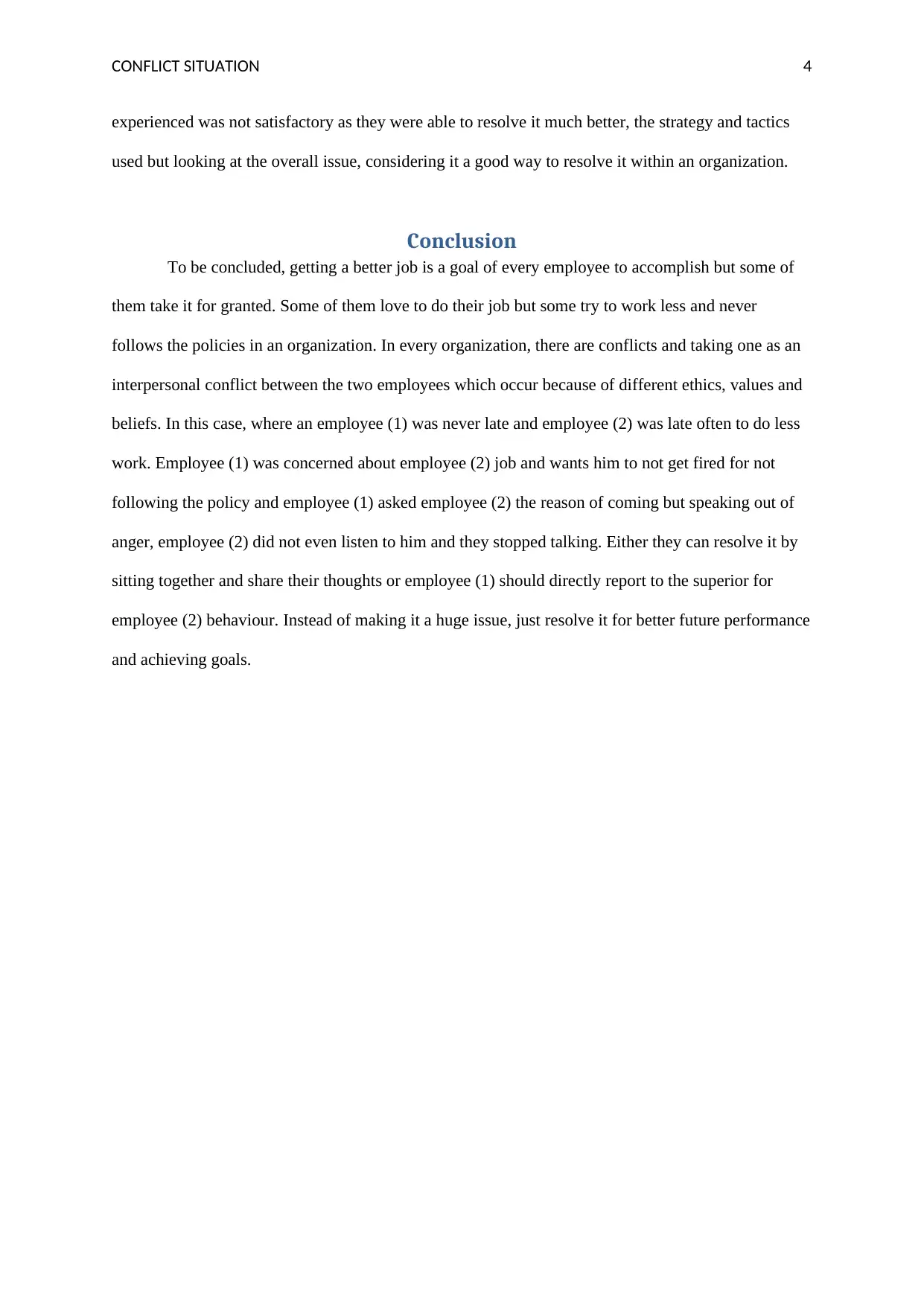
CONFLICT SITUATION 4
experienced was not satisfactory as they were able to resolve it much better, the strategy and tactics
used but looking at the overall issue, considering it a good way to resolve it within an organization.
Conclusion
To be concluded, getting a better job is a goal of every employee to accomplish but some of
them take it for granted. Some of them love to do their job but some try to work less and never
follows the policies in an organization. In every organization, there are conflicts and taking one as an
interpersonal conflict between the two employees which occur because of different ethics, values and
beliefs. In this case, where an employee (1) was never late and employee (2) was late often to do less
work. Employee (1) was concerned about employee (2) job and wants him to not get fired for not
following the policy and employee (1) asked employee (2) the reason of coming but speaking out of
anger, employee (2) did not even listen to him and they stopped talking. Either they can resolve it by
sitting together and share their thoughts or employee (1) should directly report to the superior for
employee (2) behaviour. Instead of making it a huge issue, just resolve it for better future performance
and achieving goals.
experienced was not satisfactory as they were able to resolve it much better, the strategy and tactics
used but looking at the overall issue, considering it a good way to resolve it within an organization.
Conclusion
To be concluded, getting a better job is a goal of every employee to accomplish but some of
them take it for granted. Some of them love to do their job but some try to work less and never
follows the policies in an organization. In every organization, there are conflicts and taking one as an
interpersonal conflict between the two employees which occur because of different ethics, values and
beliefs. In this case, where an employee (1) was never late and employee (2) was late often to do less
work. Employee (1) was concerned about employee (2) job and wants him to not get fired for not
following the policy and employee (1) asked employee (2) the reason of coming but speaking out of
anger, employee (2) did not even listen to him and they stopped talking. Either they can resolve it by
sitting together and share their thoughts or employee (1) should directly report to the superior for
employee (2) behaviour. Instead of making it a huge issue, just resolve it for better future performance
and achieving goals.
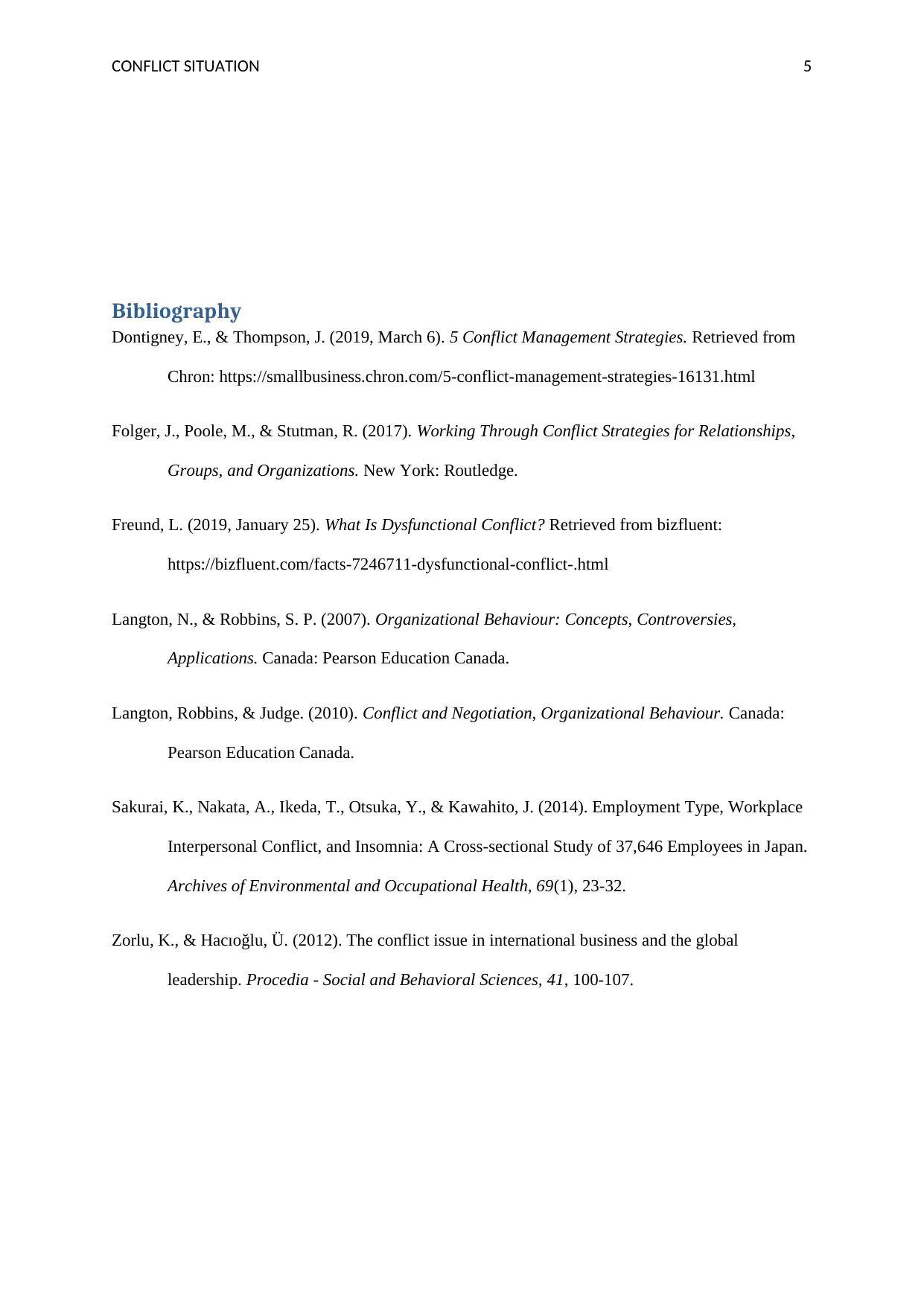
CONFLICT SITUATION 5
Bibliography
Dontigney, E., & Thompson, J. (2019, March 6). 5 Conflict Management Strategies. Retrieved from
Chron: https://smallbusiness.chron.com/5-conflict-management-strategies-16131.html
Folger, J., Poole, M., & Stutman, R. (2017). Working Through Conflict Strategies for Relationships,
Groups, and Organizations. New York: Routledge.
Freund, L. (2019, January 25). What Is Dysfunctional Conflict? Retrieved from bizfluent:
https://bizfluent.com/facts-7246711-dysfunctional-conflict-.html
Langton, N., & Robbins, S. P. (2007). Organizational Behaviour: Concepts, Controversies,
Applications. Canada: Pearson Education Canada.
Langton, Robbins, & Judge. (2010). Conflict and Negotiation, Organizational Behaviour. Canada:
Pearson Education Canada.
Sakurai, K., Nakata, A., Ikeda, T., Otsuka, Y., & Kawahito, J. (2014). Employment Type, Workplace
Interpersonal Conflict, and Insomnia: A Cross-sectional Study of 37,646 Employees in Japan.
Archives of Environmental and Occupational Health, 69(1), 23-32.
Zorlu, K., & Hacıoğlu, Ü. (2012). The conflict issue in international business and the global
leadership. Procedia - Social and Behavioral Sciences, 41, 100-107.
Bibliography
Dontigney, E., & Thompson, J. (2019, March 6). 5 Conflict Management Strategies. Retrieved from
Chron: https://smallbusiness.chron.com/5-conflict-management-strategies-16131.html
Folger, J., Poole, M., & Stutman, R. (2017). Working Through Conflict Strategies for Relationships,
Groups, and Organizations. New York: Routledge.
Freund, L. (2019, January 25). What Is Dysfunctional Conflict? Retrieved from bizfluent:
https://bizfluent.com/facts-7246711-dysfunctional-conflict-.html
Langton, N., & Robbins, S. P. (2007). Organizational Behaviour: Concepts, Controversies,
Applications. Canada: Pearson Education Canada.
Langton, Robbins, & Judge. (2010). Conflict and Negotiation, Organizational Behaviour. Canada:
Pearson Education Canada.
Sakurai, K., Nakata, A., Ikeda, T., Otsuka, Y., & Kawahito, J. (2014). Employment Type, Workplace
Interpersonal Conflict, and Insomnia: A Cross-sectional Study of 37,646 Employees in Japan.
Archives of Environmental and Occupational Health, 69(1), 23-32.
Zorlu, K., & Hacıoğlu, Ü. (2012). The conflict issue in international business and the global
leadership. Procedia - Social and Behavioral Sciences, 41, 100-107.
⊘ This is a preview!⊘
Do you want full access?
Subscribe today to unlock all pages.

Trusted by 1+ million students worldwide
1 out of 6
Related Documents
Your All-in-One AI-Powered Toolkit for Academic Success.
+13062052269
info@desklib.com
Available 24*7 on WhatsApp / Email
![[object Object]](/_next/static/media/star-bottom.7253800d.svg)
Unlock your academic potential
Copyright © 2020–2025 A2Z Services. All Rights Reserved. Developed and managed by ZUCOL.




